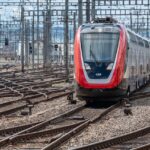We have supported the digital automatic coupler (DAK) since its beginnings. That is why we are involved in the international umbrella organisation of wagon keepers UIP, the European DAC Delivery Programme (EDDP) and the Swiss DAK migration project. However, much remains to be done at all levels. Here is an interim update on technical and market developments.
Here’s what it’s all about:
- Technology still raises questions
- Fair cost-benefit transfer sought
- Rising transport prices can bring about a shift back to the roads
- Cooperation with Europe: a must
- DAK as basis for fundamental system change
Together with the Federal Office of Transport (FOT), SBB Cargo and the Association of Public Transport (VöV), we at the VAP are driving the Swiss DAK project forward. Initial findings from this cooperation were recorded in the concept report “Automation in rail freight transport in Switzerland, starting with the migration to digital automatic coupling” of 24 October 2022. They were also incorporated into the current consultation draft on the future of Swiss freight transport and – with some additions – into the dispatch that the Federal Council is preparing for parliament in summer 2023. Numerous workshops and bilateral discussions with the rail freight sector have given rise to questions, criticisms and possible solutions that now need to be explored in greater depth.
The technology raises questions
Defining the coupling head was a first milestone. Now it is time to develop and test the digital elements. Two technical approaches are being pursued for this. With “Powerline-Plus”, the electrical impulses and data are transmitted over the same line with a limited number of contacts. In Switzerland, a consortium of experts will be testing this approach in the coming months. In the “Single Pair Ethernet” (SPE) model, on the other hand, separate lines are needed for power and data transmission.
Questions such as these remain open with both technical approaches:
- Under what weather and climatic conditions is reliable operation possible?
- Are there downtimes in data transmission during the numerous operational processes (shunting, travel (tight radii, inclines …)?
- Finally, what functionalities does the digital component contain?
- How will the upward compatibility be designed, especially from DAK4 to DAK5?
- How will the Europe-wide compatibility of the future DAK rolling stock be ensured?
- Currently, the European railway sector has only a few experts on this topic, which is a great challenge. There is also a need for clarification on mechanical aspects such as the force effects of the new coupling on the individual wagon types or the installation of the DAK in locomotives due to weight and/or space problems or the safe integration into the vehicle control technology. Questions like these must be answered by 2026.
Cost-benefit transfer can bring about a reverse shift
Investments in DAK migration are considerable, especially for vehicle owners. We assume costs of CHF 20,000 to CHF 40,000 for wagons (depending on wagon type) and CHF 60,000 to CHF 250,000 for locomotives. However, positive effects for the vehicle owners will only become noticeable after complete migration, i.e. after ten years at the earliest. This means that costs will rise in the first few years without additional revenue, which will lead to higher prices for wagon hire. The railway undertakings (RUs) will also have additional expenses during the migration phase of several years due to parallel operation. High price sensitivity could cause a shift back to the roads. We already noticed this effect in 2023 with the passed-on price increases due to increased traction current costs.
We at the VAP are looking for solutions to these challenges:
- How can the RUs, as the main winners of the DAK, pass on the efficiency gains and cost savings to the vehicle owners? In monopoly-like structures such as single wagonload traffic, market-based mechanisms do not work.
- How high do subsidies (A‑fonds-perdu contributions, loans, funds) have to be in order to compensate for the unequal cost-benefit transfer, and how can a major shift back to the road during migration be prevented? What happens if subsidies or subsequent financing to the state-owned RUs are almost completely discontinued with the DAK?
Investing in new rolling stock is certainly conceivable or even necessary for many wagon owners. But the real question is how existing fleets can be efficiently converted. In doing so, it is important to take the following aspects into account without disadvantaging players through no fault of their own:
- Even with newer rolling stock, there are difficulties in retrofitting a DAK.
- The purchase of new cars has become 50 percent more expensive due to increased raw material prices.
- The production of new cars with DAK has to be started after the specifications have been finalised. The number of units is limited at the beginning depending on the type of wagon.
- Older rolling stock with a simple conversion causes lower additional costs.
- Different vehicle owners own identical types. The conversion of the type vehicle must be independent of the keeper and the high one-off costs must be covered.
Track to track with Europe
The majority of those involved agree: only in close cooperation with Europe can we master sustainable migration. The technical and operational challenges of conversion are similar on both sides of the border. Questions about the conversion process up to successful implementation and financing can only be answered if all experts and decision-makers are at the table. Unfortunately, that is only a handful.
Our contribution from Switzerland is to deal with the national circumstances and to prepare the groundwork well. This includes launching pilot transports; the first DAK test trains have been running in Switzerland since April 2023. We should gather this experience and incorporate it into the pan-European project.
We would like to show that efficient and sustainable innovation at European level is only possible together, using the following examples:
- Coordinate workshop capacities: Coordination between the countries and wagon keepers must be ensured in order to have the wagons to be converted in operation (national and international relations) routed to the nearest or best possible workshop and returned again.
- Align funding requirements. The prerequisite for funding is usually an entry in the vehicle register and/or a registered office in the respective country. However, as wagons are not always used in that country but move throughout Europe, funding must be secured for wagon keepers in all countries at the time of migration.
- Coordinate migration timetable. Early migration leads to new interfaces in rail freight transport. Specifically, a wagon converted and funded in Switzerland cannot run in Germany as long as the DAK migration has not started there and the corresponding import and export transports have not been coordinated. In addition, the vehicle owner can only use his fixed assets to a limited extent.
- Bring decision-making bodies together: The technical solutions are adopted in the specified bodies of the EU and then adopted by Switzerland. Integrating these resources into the EU project would be more expedient than having Switzerland set up its own organisation.
In order to contribute to the overall realisation at EU level, we in Switzerland must concentrate on the preparatory work with all the companies concerned and actively push ahead with our test phases and pilot transports. We cannot afford any teething troubles with the products and specifications.
Basis for a fundamental system change
The DAK is not a technical undertaking, but the beginning of the necessary digitalisation and integration of rail freight transport into a sustainable logistics chain. With the DAK, elements such as automatic brake testing, automatic recording of the wagon sequence, train integrity control or electro-pneumatic braking are added in addition to the coupling process.
In order for the DAK to unfold its full technical effect and give rail freight transport the necessary market dynamics, we have to work on the following aspects before the start of migration:
- Redefine operational processes
- Adapt regulatory requirements and regulations and simplify timeframes
- Prepare and adapt infrastructure and sidings
- Train affected groups for migration and operation
- Automate inspections and maintenance
- Automate transport information for shippers
- Effectively protect digital data from unauthorised access
We at the VAP also aim to launch a data platform and exchange data in the sense of an eco-data system. We are convinced that the DAK will only bring the necessary and large-scale added value to the railway sector with the exchange of data. We are therefore very pleased that despite initial scepticism from the sector, the FOT has taken up this aspect. It also intends to include freight transport in the planned Mobility Data Infrastructure (MODIG). In our next blog on the DAK, you can read about the extent to which the DAK contributes to an innovative, self-sufficient and customer-oriented rail freight transport system and how the letter K can therefore be translated primarily as connectivity.



